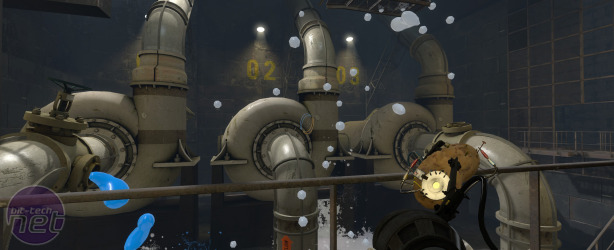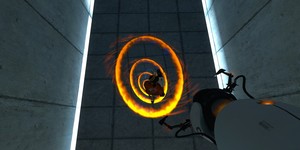
Portal 2 Video
Chief among Valve’s technological marvels in Portal 2 is the cinematic physics system that was rolled out in Half-Life 2: Episode 2 and which was used for all the big demolition scenes. In Portal 2 it’s used more for construction, however – such as when Wheatley or GlaDOS seize control of a room’s modular panels and remake the levels as they wish.While it’s probably possible to view the rippling walls and floors as a mundane scripted sequence, we found we were constantly impressed by the ingenuity of its application and the complexity of the movements. Whether it’s Wheatley clearing corridors by shunting debris into hidden compartments, or GlaDOS rolling out a surprise addition to the latest puzzle, these sequence consistently added to both the setting and the characters themselves.
The constantly shifting landscapes also bring extra challenges to the game. Not only do you always have to bear in mind that your carefully plotted solution to an experiment may be ruined by change of layout, but you’ll also be harder pushed to find the secret areas that lurk behind the scenes.
The difficulty curve is one area where Portal 2 definitely fumbles, however; mainly because it’s as flat as a pancake. Most of the singleplayer levels can be easily breezed through in just a matter of minutes and, while Valve has disguised this ease by constantly rolling out new toys to master, it’s clear that Portal 2 isn’t going to furrow anyone’s brow for very long.
In a way, this is a good thing; giving the impression of always moving forwards, rather than leaving you with your head in your hands and murder in your eyes. On the other hand, it makes those few late-game levels that really do require pause for thought seem like a sudden and unfair change of pace. The co-operative campaign, which casts two players as robotic test subjects Pea-Body and Atlus, helps offset this disappointment, however – if you’re looking for a real brain-strainer then the two-player mode is clearly the best place to start. Bring along a sullen and stupid friend if you want a real challenge.
The pace of the singleplayer campaign remains Portal 2’s biggest weakpoint, however. In some ways it seems that Valve’s almost unable to win, as it gets caught up in a damaging spiral of cause and effect. The impressive detail of the levels necessitates too-frequent disruption from load screens, for example.
The difficulty and the pace of Portal 2 conspire against each other especially. While the brevity of individual puzzles is offset by their greater numbers, the fact that none of the many puzzles is any harder means Portal 2 often feels like it’s been a bit padded. You may be breezing through puzzles and hurtling through chambers at an unprecedented rate, but only rarely does it feel like you’re moving noticeably closer to an identifiable goal. More often you’re just jumping blindly from one chamber to the next; an odd thing to take away from a sequel focusing on more overt rebellion than the first.
Oddly, Valve seems to have encouraged this feeling at some points of the game. Several times are you told about the surprises waiting for you five or six chambers down the line – a tactic which doesn’t work as well in the sequel as it did with the cake-based promises of the original. Portal 2’s ending is oddly structured for a Valve game too, stripping control from the player and unfolding as a video cutscene rather than in-game action – the first time the tactic has been used in a game in the Half-Life universe.

MSI MPG Velox 100R Chassis Review
October 14 2021 | 15:04










Want to comment? Please log in.